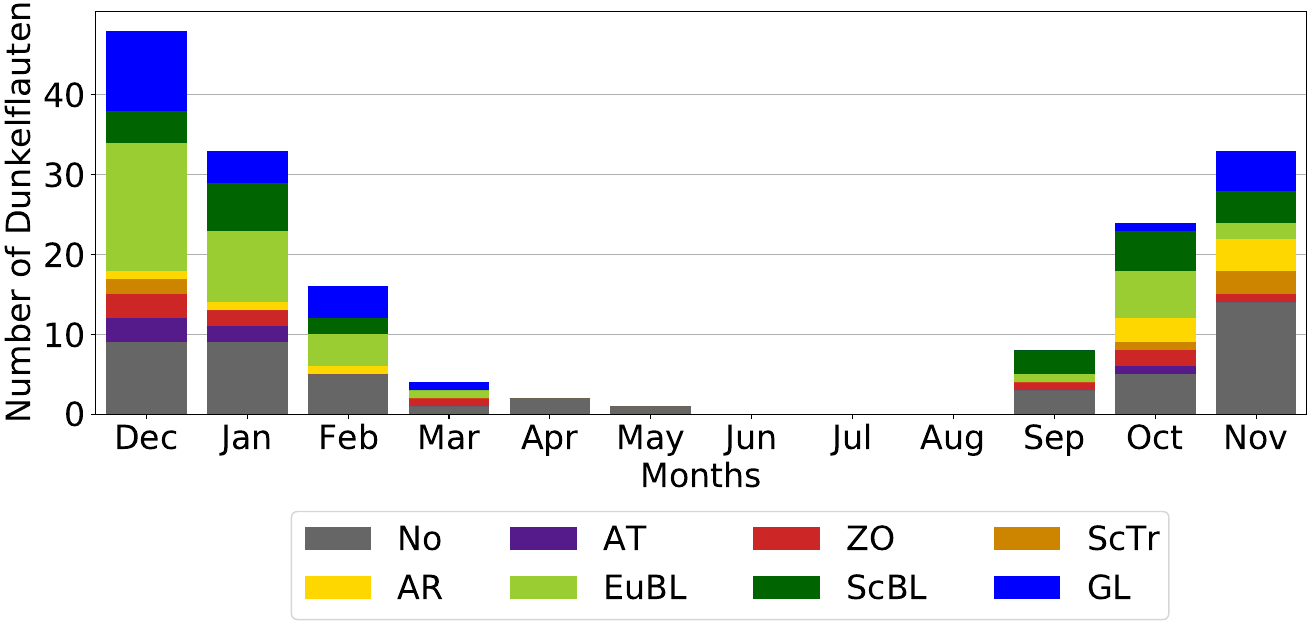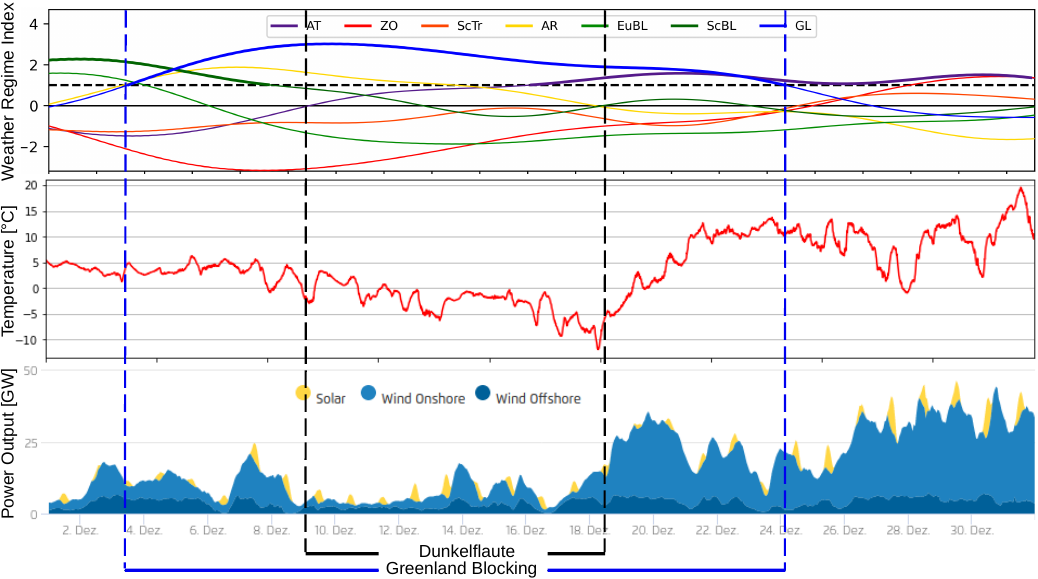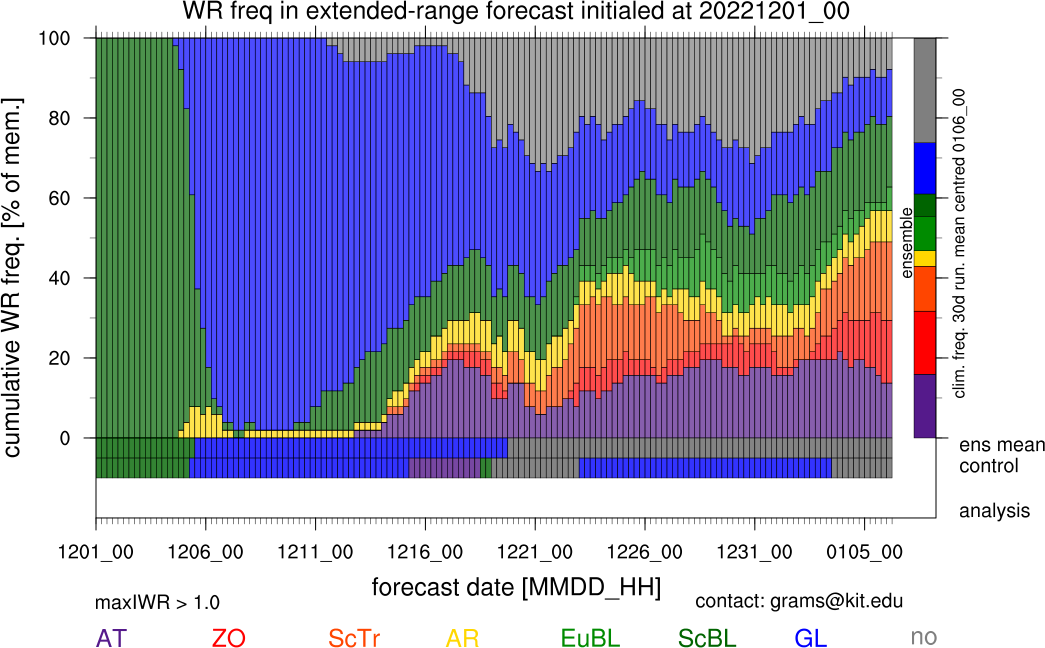Using weather regimes to better predict Dunkelflauten in Germany?
In December 2022, Germany experienced a period of calm, cloudy and extremely cold conditions for multiple consecutive days (December 10th to 18th, we further elaborate on this period at the end of the article). With the increase in the share of solar and wind power in the electricity system and an increase in demand due to electrification of heat, the power system becomes increasingly sensitive to meteorological conditions like those in December 2022.
Periods of calm and cloudy conditions for multiple consecutive days are called Dunkelflauten (from the German word for dark wind lulls). The particular case of a Dunkelflaute in combination with colder than normal conditions is called a cold Dunkelflaute.
Predicting Dunkelflauten events well ahead of time is becoming more and more important for grid operators to prepare for potential shortages in supply and to plan a resilient energy system.
The variability of the large-scale atmospheric circulation in the North Atlantic-European region can be described by weather regimes (Grams et al., 2017). At the same time weather regimes modulate surface weather conditions (e.g., wind speed, temperature, solar irradiation) over country-size regions, e.g., Germany and multi-day periods. Therefore, weather regimes are particularly useful for sub-seasonal weather forecasts for the next 10-30 days. Understanding a potential link between weather regimes and Dunkelflauten might help anticipating Dunkelflauten events several weeks in advance.

Predicting Dunkelflauten events well ahead of time is becoming more and more important for grid operators to prepare for potential shortages in supply and to plan a resilient energy system.
The variability of the large-scale atmospheric circulation in the North Atlantic-European region can be described by weather regimes (Grams et al., 2017). At the same time weather regimes modulate surface weather conditions (e.g., wind speed, temperature, solar irradiation) over country-size regions, e.g., Germany and multi-day periods. Therefore, weather regimes are particularly useful for sub-seasonal weather forecasts for the next 10-30 days. Understanding a potential link between weather regimes and Dunkelflauten might help anticipating Dunkelflauten events several weeks in advance.
We distinguish four types of blocked regimes, characterised by high-pressure situations, and three types of cyclonic regimes, characterised by low-pressure situations in the North Atlantic-European region (Grams et al. 2017).
In a recent study (Mockert et al. 2022), we found that Dunkelflauten in Germany mainly occur in winter, when the solar power output is low, and the wind power output drops for several consecutive days (bars in Figure 1). Also most Dunkelflauten can be linked to three out of the four blocked weather regimes (European, Scandinavian and Greenland Blocking; colors in Figure 1). They last from two days (by definition) up to eight days and occur on average two times per winter season. The Dunkelflauten occur in a well-established weather regime and in regime life cycles which persist longer than usual. Greenland Blocking Dunkelflauten are associated with colder conditions than usual, therefore considered as cold Dunkelflauten which are likely most critical to the energy system.
One example is the already mentioned cold Dunkelflaute in December 2022. The temperature in Karlsruhe (Figure 2 middle) dropped from 5°C at the beginning of December to a minimum of -12°C on December 18th. This cold period is related to a Greenland Blocking weather regime (Figure 2 top), which has been active from December 3rd to 24th. Alongside decreasing temperatures in Karlsruhe (or, generally speaking, Germany), the power supply by renewable energy sources (wind and solar) in Germany was particularly low from December 9th to 18th (Figure 2 bottom) and thus in the middle of the Greenland Blocking regime life cycle.

Analysing the extended-range weather regime forecast from December 1st (Figure 3), it becomes clear that the Greenland Blocking was well predicted. Thus, the forecast of the particularly long-lasting Greenland blocking episode was an effective indicator for the upcoming cold Dunkelflaute.

References:
Christian M. Grams, Remo Beerli, Stefan Pfenninger, Iain Staffell, and Heini Wernli. Balancing Europe’s wind-power output through spatial deployment informed by weather regimes. Nature Climate Change, 7:557–562, 8 2017. ISSN 17586798. doi: https://doi.org/10.1038/nclimate3338 .
Fabian Mockert, Christian M. Grams, Tom Brown, Fabian Neumann. Meteorological conditions during Dunkelflauten in Germany: Characteristics, the role of weather regimes and impacts on demand. ArXiv, doi: https://arxiv.org/abs/2212.04870v1.
Fabian Mockert, Working group Large-Scale Dynamics and Predictability https://www.imk-tro.kit.edu/english/7425.php
